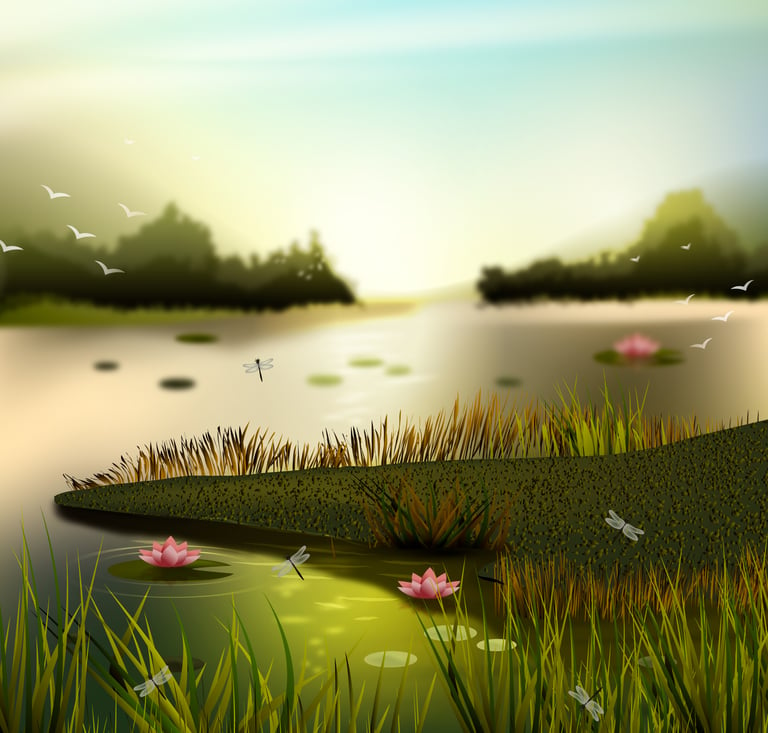"Wetlands: Nature's Powerful Ally in Climate Change Mitigation"
how wetlands help to reduce carbon dioxide and mitigation of climate change
2/9/20244 min read


what is a wetland
Wetlands are among nature's most effective tools in the battle against climate change, acting as carbon sinks, flood protectors, and biodiversity hotspots. These ecosystems, ranging from marshes and peatlands to mangroves and floodplains, play a critical role in mitigating the effects of climate change through several key processes. Understanding these processes can illuminate why wetlands are essential to global environmental health and climate stability.
Carbon Sequestration: The Underground Storage
One of the most vital roles of wetlands in climate change mitigation is their ability to sequester carbon dioxide (CO2), a primary greenhouse gas. Through the process of photosynthesis, wetland plants absorb CO2 from the atmosphere, converting it into organic matter. When plants die, the carbon stored in their biomass is transferred to the soil, where it is locked away in the anaerobic (oxygen-free) conditions typical of wetland environments. This prevents the carbon from returning to the atmosphere, effectively making wetlands significant carbon sinks. Peatlands, despite covering only 3% of the world’s land surface, store approximately 30% of all soil carbon, highlighting their importance in global carbon dynamics.
Flood Mitigation: The Natural Sponge
Wetlands act as natural sponges, absorbing and storing excess rainwater and reducing flood risks. During periods of heavy rainfall, wetlands can absorb and slowly release water, decreasing the speed and intensity of floodwaters. This capacity not only protects human communities from flood damage but also mitigates the erosion of valuable topsoil and reduces the sedimentation of rivers and lakes, preserving water quality and aquatic habitats.
Water Purification: The Natural Filter
Through a process known as bioremediation, wetlands purify water by filtering pollutants, such as pesticides, heavy metals, and other contaminants. The dense vegetation and unique soil composition of wetlands trap these pollutants, preventing them from reaching larger bodies of water. Additionally, the microbial communities within wetland soils can break down harmful substances, further cleansing the water that flows through these ecosystems.
Biodiversity Support: The Cradle of Life
Wetlands are biodiversity hotspots, supporting a wide range of plant and animal species. By providing essential habitats for various life forms, including many threatened and endangered species, wetlands contribute to maintaining ecological balance and supporting healthy ecosystems. This biodiversity plays a crucial role in ecosystem resilience, enabling wetlands to recover from and adapt to the impacts of climate change.
Coastal Protection: The First Line of Defense
Coastal wetlands, including mangroves and salt marshes, serve as the first line of defense against sea-level rise and storm surges. The roots of these plants help to stabilize shorelines, reducing coastal erosion and buffering the impact of storm waves. By diminishing the force of waves and trapping sediments, coastal wetlands protect inland areas from flooding and damage during storms.
Conclusion
Wetlands are invaluable allies in the fight against climate change, offering natural solutions to some of our most pressing environmental challenges. Through carbon sequestration, flood mitigation, water purification, biodiversity support, and coastal protection, wetlands contribute to climate change mitigation and adaptation in ways that engineered solutions cannot replicate. Protecting and restoring these ecosystems is crucial for our global climate goals and for the health of our planet. By understanding and advocating for the preservation of wetlands, we can harness nature's own mechanisms to combat climate change and ensure a resilient and sustainable future for all.
References
Mitsch, W.J., & Gosselink, J.G. (2015). Wetlands. Wiley. This book offers comprehensive coverage of wetland ecology, including the role of wetlands in carbon sequestration.
Bridgham, S.D., Megonigal, J.P., Keller, J.K., Bliss, N.B., & Trettin, C. (2006). "The carbon balance of North American wetlands." Wetlands, 26(4), 889-916. This study provides detailed analysis on how North American wetlands act as carbon sinks.
Tiner, R.W. (2017). "Wetland functions and ecosystem benefits." In Wetland Indicators: A Guide to Wetland Formation, Identification, Delineation, Classification, and Mapping. CRC Press. This guide explains the role of wetlands in flood control and stormwater management.
Opperman, J.J., Galloway, G.E., Fargione, J., Mount, J.F., Richter, B.D., & Secchi, S. (2009). "Sustainable floodplains through large-scale reconnection to rivers." Science, 326(5959), 1487-1488. This article discusses the importance of reconnecting rivers to their floodplains to enhance flood mitigation.
Kadlec, R.H., & Wallace, S. (2009). Treatment Wetlands. CRC Press. This book provides an in-depth look at how constructed wetlands can be used for wastewater treatment and water quality improvement.
Zedler, J.B., & Kercher, S. (2005). "Wetland resources: status, trends, ecosystem services, and restorability." Annual Review of Environment and Resources, 30, 39-74. This review highlights the ecosystem services provided by wetlands, including water purification.
Davidson, N.C. (2014). "How much wetland has the world lost? Long-term and recent trends in global wetland area." Marine and Freshwater Research, 65(10), 934-941. This research article offers insight into the importance of wetlands for biodiversity and the extent of wetland loss.
Finlayson, C.M., Davies, G.T., Moomaw, W.R., Chmura, G.L., Natali, S.M., Perry, J.E., ... & Woodroffe, C.D. (2019). "The Second Warning to Humanity – Providing a Context for Wetland Management and Policy." Wetlands, 39(1), 1-5. This paper discusses the critical role of wetlands in supporting global biodiversity.
Gedan, K.B., Kirwan, M.L., Wolanski, E., Barbier, E.B., & Silliman, B.R. (2011). "The present and future role of coastal wetland vegetation in protecting shorelines: Answering recent challenges to the paradigm." Climatic Change, 106(1), 7-29. This study evaluates the effectiveness of coastal wetlands in protecting shorelines from erosion and sea-level rise.
Barbier, E.B., Hacker, S.D., Kennedy, C., Koch, E.W., Stier, A.C., & Silliman, B.R. (2011). "The value of estuarine and coastal ecosystem services." Ecological Monographs, 81(2), 169-193. This monograph assesses the economic and protective value of coastal ecosystems, including wetlands.
